Kanchanaburi : Bridge over River Kwai, Prasat Muang Singh. Suphanburi Province.
Kanchanaburi is one of Thailand's largest provinces. Nature has been generous to the province with mountains, waterfalls, rivers and countryside scenery. It is also infamous for its death railway, constructed during World War II by the Japanese, at the expense of the lives of many thousands prisoners of war.
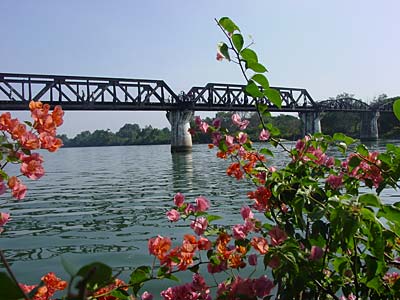
The Bridge over the River Kwai now is a major tourism attraction. We recommend caution when walkin over the bridge. It is often crowded and it is easy to fall to your death when taking a wrong step.
Nowadays a yellow Disneylike train makes regular trips over the bridge, dispersing the people walking on it to a safe place. We also noticed a real train passing the bridge, of course mainly occupied by tourists and local school children.
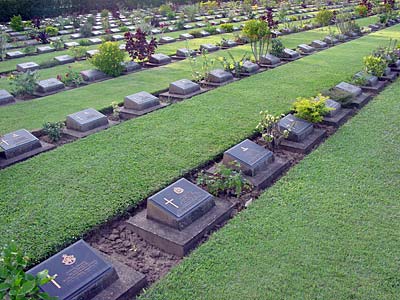
The war cemetery, close to the Bridge, has the graves of many thousands of British, Dutch and Australian prisoners of war who died while building the bridge. The cemetery is very well kept.
A well visited museum in Kanchanburi is the JEATH war museum. The museum is a replica of the bamboo huts used to house the prisoners of war. It contains many photos, paintings, news clips (interviews after the war) and war memorobilia. This museum is well visited. We wonder however why nothing more substantial is being erected to honor the many who died during the war.
While in Kanchanaburi, we recommend a visit to Prasat Muang Singh historical park. You will need your own transport to get there. It is located about 40 km west of Kanchanaburi. Prasat Muang Singh was the most western outpost of the Khmer empire during the 13th century. The main structure faces east towards Angkor (present day Cambodia). Contrary to most Khmer temples, Muang Singh is considered a Mahayana Buddhist monument.
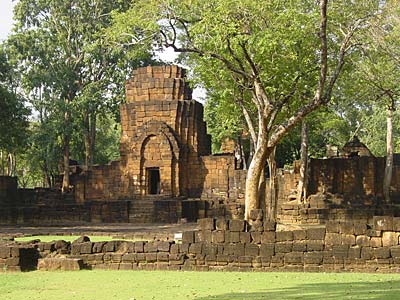
The main group of ruins at Prasat Muang Singh.
As most historical parks in Thailand, Prasat Muang Singh is very well maintained, and offers pleasant walking among the ruins.
.jpg)
Prasat Muang Singh. Statue within the main structure.
During the construction of the Death Railway, a Dutch prisoner of war, named Van Heekeren, found some Neolithic remains in the vicinity. Archaeologic excavations were performed after the war, and a museum called Ban Kao offers a display of archaeological finds. It is located about 5 km from Prasat Muang Singh.
Next stop : Suphanburi.
Suphanburi is well known as the home province of former prime minister Banharn Silapa-Archa.
Its infrastructure is better developed than in most other provinces.
Wat Pa Lelai houses a large Buddha image in the so called European fashion (of sitting). The image has been often remodeled during its centuries old existence. This temple does not offer other important structures to visit. The image is much revered by local people and you will that the place is crowded with worshippers.
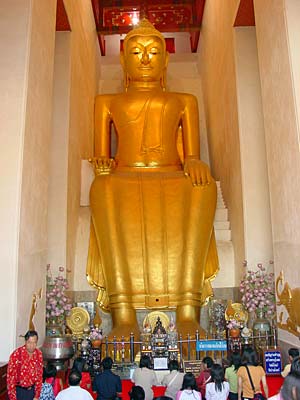
Buddha image at Wat Pa Lelai. The sitting position observed is in the so-called European fashion.
As most provincial capitals in Thailand, Suphanburi has also a temple called Wat Mahathat. It is a large compound that however is rather quiet and not much active (at least when we visited). It both houses new structures and delapidated buildings. A large Lopburi style Khmer prang, still surrounded by some stucco, is its main attraction.
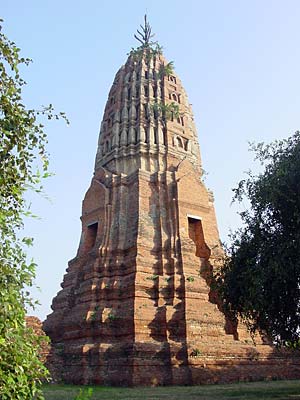
Prang at Wat Mahathat, Suphanburi
U Thong National Museum is another major attraction in Suphanburi province. As the National Museum in Nakhon Pathom, it has a lot of fine Dvaravati art on display. The museum is located 7 km west of the provincial capital.
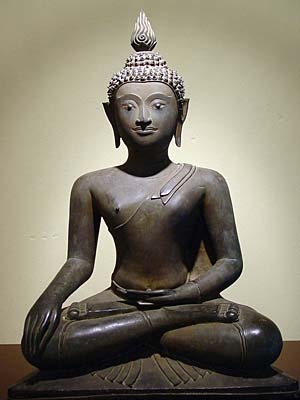
Buddha subduing Mara - ca. 16th century in Ayutthaya style. U Thong National Museum.

